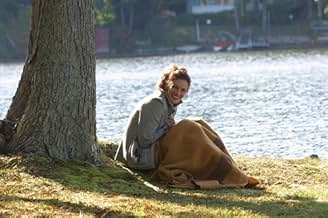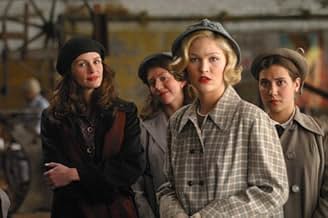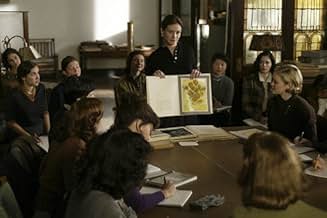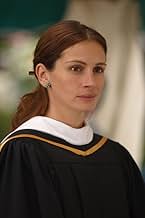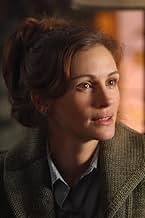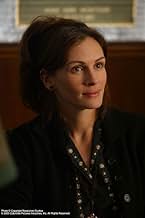Katherine Watson teaches art history in 1953 at the respectable all-female Wellesley College. She encourages her conservative students to question and disregard the outdated societal mores f... Read allKatherine Watson teaches art history in 1953 at the respectable all-female Wellesley College. She encourages her conservative students to question and disregard the outdated societal mores for women.Katherine Watson teaches art history in 1953 at the respectable all-female Wellesley College. She encourages her conservative students to question and disregard the outdated societal mores for women.
- Awards
- 6 nominations total
- Director
- Writers
- All cast & crew
- Production, box office & more at IMDbPro
Featured reviews
Despite these flaws, there is still a lot to recommend it. The film is very well made, with dazzling cinematography and picturesque scenery. And the costumes, hairstyles and makeup were beautiful. The music is lovely, very pleasant and soothing. Making the most of their rather stereotypical characters, the actors acquit themselves well. I admit it, I don't often care for Julia Roberts, but here she makes for a sympathetic lead as the unconventional art lecturer and does it more than adequately. Solidly supporting her as the students are Julia Stiles, Maggie Gyllanhaal and Kirsten Dunst especially. The film is ably directed too, and is emotionally manipulative, not in a bad way though. All in all, it is a very earnest and well made film, but as a drama it doesn't quite convince as much as it should've done. 7/10 Bethany Cox
Another thing that pleased me was the film's assumption of an intelligent, educated audience that does not require any dumbing-down of art and culture. "Mona Lisa Smile" rattles off names of artists and their works as if it fully expected moviegoers to be conversant with them. In at least one case, the film names neither the artist nor the work (Picasso's "Demoiselles d'Avignon"). All of these things are taken as givens, as part and parcel of a sophisticated audience's cultural baggage -- quite a change from the usual pap that Hollywood spoonfeeds us!
Moreover, the film sometimes speaks volumes by what it doesn't say but simply shows, taking for granted that we will fill in the blanks from our knowledge of the history of the period (that is, the early 1950s). There is one oblique reference to McCarthyism. A photo of an atomic explosion reminds us of the post-WWII, Cold War era. A game show on TV triggers a memory of the payola scandal. Again, "Mona Lisa Smile" credits us with brains rather than insulting our intelligence.
Mercifully, the title of the film is not simply a reference to Julia Roberts' famous beestung, collagen-enhanced lips. As Kirsten Dunst's character explains toward the end of the movie, Mona Lisa's smile is not necessarily an indication that she is happy and content -- any more than the women of the 1950s with their dream homes and seemingly perfect lives. "Mona Lisa Smile" is ultimately an indictment of those in society who perpetrate and perpetuate secrets and lies, and a tribute to those through whom the truth prevails.
But...
"The devil is in the details," as they say, and this picture has just enough surprises, just enough charm, just enough fine acting to make it worth watching. Movies do not have to be real to be worthwhile, they just have to be about real things. The questions "Mona Lisa Smile" covers are still very much with us, and may provoke considerable discussion in your house. This film is respectful enough of its subject matter and well-enough executed to make it a much better way to spend your time than most of what's out there now. Don't believe the sourpusses, this one's a good'un.
Did you know
- TriviaIn order to prepare for their roles, the leads were all put through a finishing school two weeks prior to filming. However, in contrast to the film's depiction, Wellesley College was never a finishing school. It was a private women's liberal arts college which emphasized social activism.
- GoofsAt the wedding, champagne is served in flute glasses. They were rarely used until the 1970s, when drier vintages became preferred. In the 1950s, champagne was served in champagne coupe (or saucer) glasses. They are still used in champagne fountains at weddings.
- Quotes
Betty Warren: [Narrating] My teacher, Katherine Watson, lived by her own definition, and would not compromise that. Not even for *Wellesley*. I dedicate this, my last editorial, to an extraordinary woman who lived by example and compelled us all to see the world through new eyes. By the time you read this, she'll be sailing to Europe, where I know she'll find new walls to break down and new ideas to replace them with. I've heard her called a quitter for leaving, an aimless wanderer. But not all who wander are aimless, especially not those who seek truth beyond tradition, beyond definition, beyond the image.
- Crazy creditsThe end credits for the prominent cast and crew are set in front of vintage footage and advertisements showing women in the 1940s and '50s.
- SoundtracksLift Thine Eyes
from "Elijah"
Written by Felix Mendelssohn
Performed by Wellesley College Chamber Singers
Lisa Graham Conductor
Under license from Wellesley College Chamber Singers
- How long is Mona Lisa Smile?Powered by Alexa
- What's the idea behind the movie's title?
- How does the movie end?
Details
- Release date
- Country of origin
- Official sites
- Languages
- Also known as
- La sonrisa de Mona Lisa
- Filming locations
- Production companies
- See more company credits at IMDbPro
Box office
- Budget
- $65,000,000 (estimated)
- Gross US & Canada
- $63,860,942
- Opening weekend US & Canada
- $11,528,498
- Dec 21, 2003
- Gross worldwide
- $141,337,989
- Runtime1 hour 57 minutes
- Color
- Sound mix
- Aspect ratio
- 1.85 : 1
Contribute to this page








